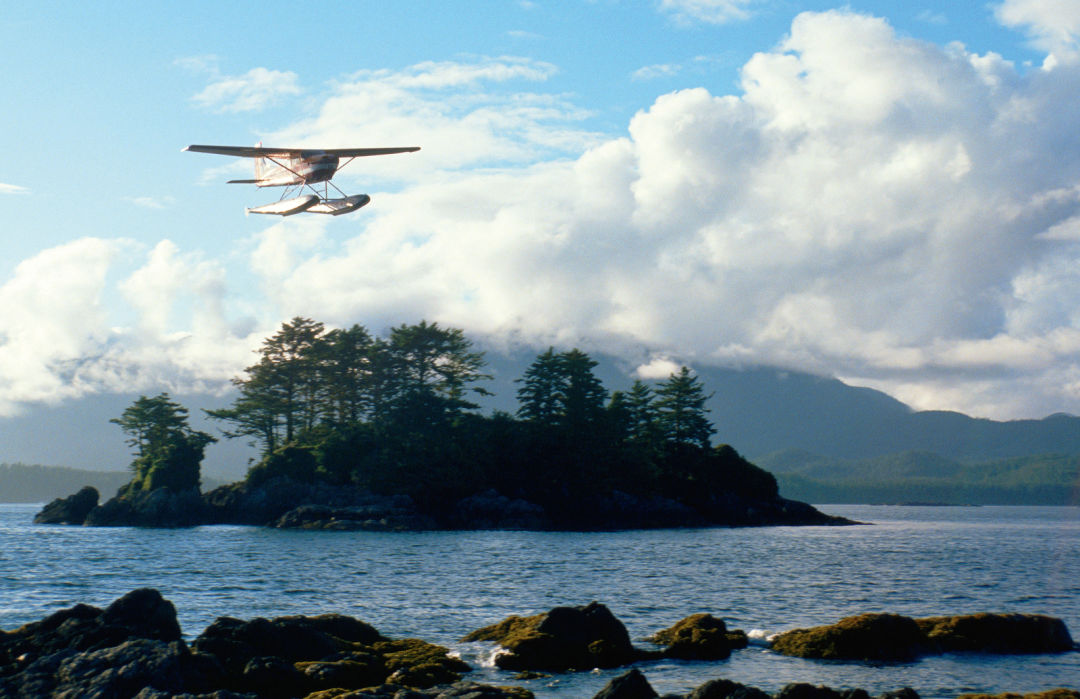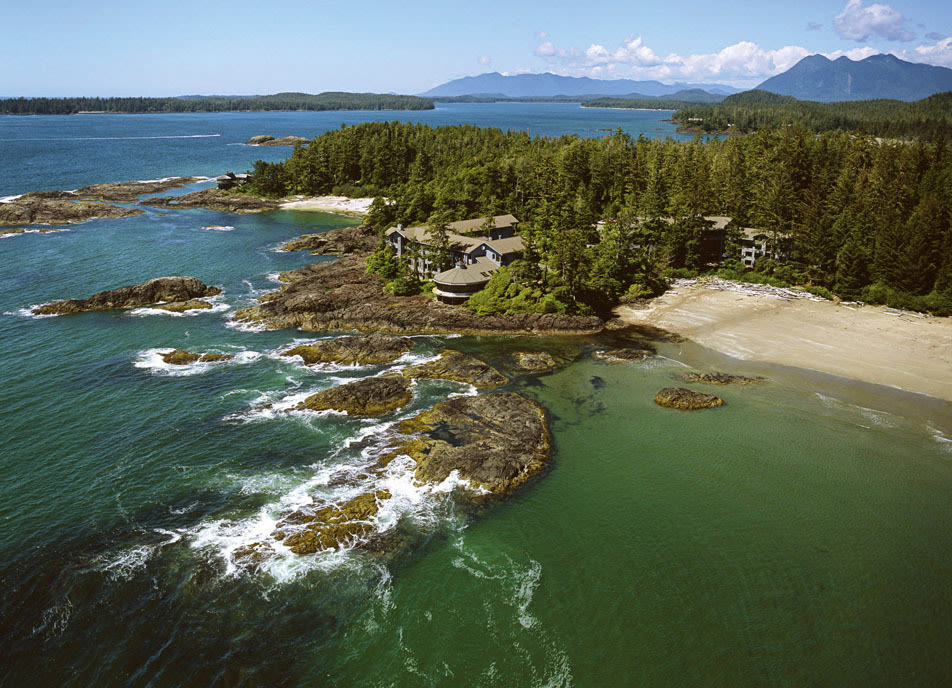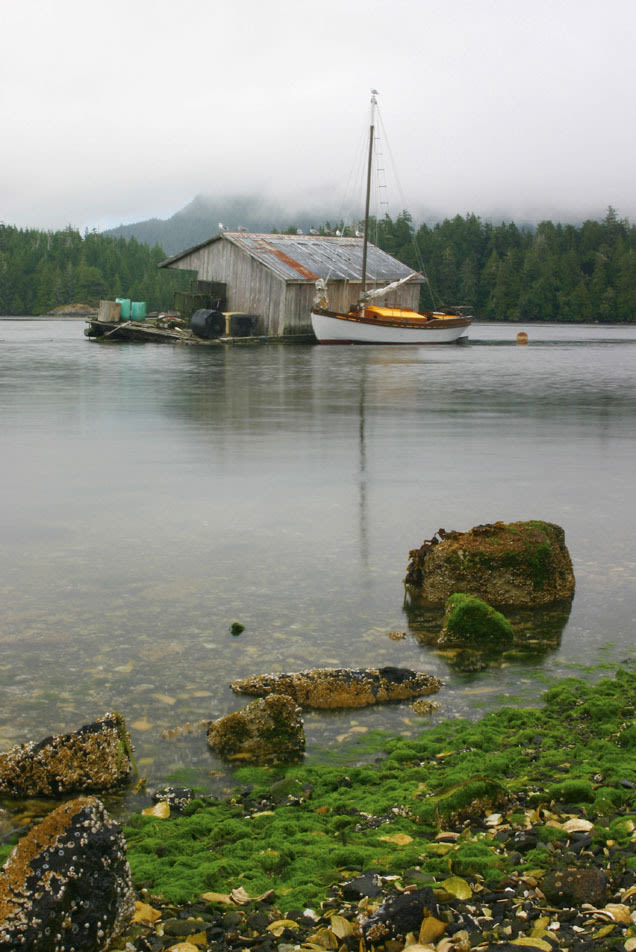The Wild Side

You can ply the waters of Vancouver Island’s Clayoquot Sound in a kayak–or, if you prefer, view them from above.
Image: Store/Designer Site
I’M LOUNGING on the elevated outdoor deck of Tofino’s Inn at Tough City, a cup of sweet, high-grade sake and a plate of fresh Dungeness crab futomaki in front of me, trying to envision what this remote village must have looked like before all the adventure travelers arrived. As far as mental exercises go, in some respects this is an easy one, for the jaw-dropping natural setting around me—the cobalt blue waters of Clayoquot Sound and the fog-tipped, emerald slopes of cedar and spruce—has remained largely unchanged for tens of thousands of years.
But Tofino itself, perched on the tip of a slender peninsula that juts from Vancouver Island’s western shore, has undergone huge cultural and demographic shifts over the past two decades. Once upon a time, this was just another fishing and logging village, the kind of place where residents had to come to terms with extreme isolation (the town is a 4.5-hour drive from the nearest major airport in Victoria) and extreme rains (Tofino averages 135 inches of precipitation each year)—or else go stark raving mad. Today, the scene has changed: Lattes steaming at the Raincoast Café, galleries selling sculptures and paintings, and fresh-faced visitors signing up for kayaking and whale-watching excursions tell the story of the local economy’s transformation from resource extraction to tourism.
Precisely how little burgs like Tofino become the “It” place among the travel cognoscenti is always a bit of a mystery. Similar evolutions have occurred in Mexico’s San Miguel de Allende, a town encircled by mountains in the state of Guanajuato that is known for its Colonial architecture and natural hot springs; and in Santa Fe, New Mexico, which lost some of its quaintness to legions of tourists and Texas retirees lured there by the scent of piñon and by the town’s adobe mystique.
Environmental activism, however, played a leading role in shaping present-day Tofino. In one of the largest episodes of civil disobedience in Canadian history, hundreds converged on the town in 1993 to protest old-growth logging practices, and over the course of a highly publicized yearlong campaign, footage of the place was delivered to television sets across the country. To landlocked citizens in places like Edmonton and Toronto, Tofino’s sweeping beaches and world-class surf breaks; tracts of virgin temperate rain forest (the largest in North America); and web of inlets populated by gray and humpback whales must have looked enticing.
American travel magazines “discovered” the town not long afterward, and soon, publications were trying to one-up each other with better photography and more bedazzling accounts of up-close whale encounters. When Clayoquot Sound—the approximately 865,000 acres of mountains, forests, rivers, waterways, and coastline that surround Tofino—was named a UNESCO Biosphere Reserve in 2000, it not only protected much of the area from loggers’ saws, but also gave the region yet another public-relations booster shot.

Image: Wickaninnish Inn
Now Canadian singer Sarah McLachlan owns an oceanfront home just down the beach, and John Travolta, Danny DeVito, Alanis Morissette, and Donald Sutherland, among other celebrities, are rumored to have sauntered along Main Street. Buzz doesn’t get much louder than the sound of celebrity laughter echoing off the village’s streets.
“We were pretty awesome out here already, before all that,” says 34-year-old Robin Cargill, a manager at Tofino Sea-Kayaking Company. The shop does quadruple duty as a bookstore, bed-and-breakfast, kayaking school, and espresso bar, and even though the kayak business is profiting from the changing economy, Cargill’s voice contains a note of mild disappointment. But as with any town that’s located in the midst of such beauty, a lot of people, understandably, want a little piece of it.
The fact that Tofino is no longer a place to be discovered didn’t diminish my own desire to visit. My wife and I first came to the town as honeymooners in 2004, and our trip to nearby Hot Springs Cove, among other experiences, guaranteed that we would be back. We often recounted (to anyone who would listen) the 25-minute walk we took along a boardwalk that undulated through a forest of coastal cypress. The path, dramatic in itself, ended at a series of natural pools, where steaming water bubbled up from the earth just a few feet from the ocean’s incoming waves. We soaked for most of the afternoon.
On that same vacation, we ate a memorable meal at Sobo, an old purple lunch truck parked near the Tofino Botanical Gardens that is justifiably famous for its crisp polenta fries and wild salmon chowder. This time, however, when we went looking for that lunch truck again, we found that chef Lisa Ahier had upgraded her digs to a full-fledged, four-walled restaurant—owing, no doubt, to the popularity of her exceptional cuisine.
We also were determined to get out on the water this trip, so we joined Tofino Sea-Kayaking Company’s half-day excursion through Lemmens Inlet. Our group of five circled the shores, the browns and yellows and pinks of undersea creatures visible just a few feet below our boats, while kayaking guide Candice Stevens, born and raised in Tofino, pulled up some kelp and took a few salty bites—the ultimate lesson in eating local.
At Meares Island, we left our boats and hiked the Big Tree Trail, an aptly named path that winds through groves of 1,000-year-old cedar and spruce. When we arrived at an unexpectedly open area of the forest, Stevens stopped at the upended base of a hulking tree. “She’s called the Big Mother,” Stevens said of the conifer, which blew down last year during a winter storm. The tree’s root system was the size of my house.
After our kayaking excursion, we headed to Tonquin Park, a small cove surrounded (as everything here is) by undulating hills. A short distance away, we could see the edge of town—and everywhere else, we saw more of the landscape that draws people to Tofino and that keeps bringing them back: a sweet stretch of beach, the untouched forest, and the wide, cerulean sea.

The Guide
Tofino
GO
Regional carriers such as Orca Airways run daily flights to Tofino’s small-plane airport from Vancouver or Victoria. (888-359-6722)
Most people, however, take the ferry from Seattle to Victoria or Nanaimo, on the east side of Vancouver Island, and then drive. Tofino is about a 4.5-hour drive from Victoria, but the views of mountains, old-growth Douglas fir, and the shores of Kennedy Lake make it easy on the eyes.
EAT
Sobo, a pillar of Tofino cuisine, finally has upgraded its digs from an old purple lunch truck to a four-walled restaurant. Killer Fish Tacos and polenta fries—preferably drowned in spicy Caesar sauce—are huge hits, but nothing on the menu disappoints. (Lunch $4-12, dinner $20-29; 250-725-2341)
The Pointe (at the Wickaninnish Inn) Even if you’re not staying at “the Wick,” a splurge on a meal is entirely worth it. Set on a rocky perch with huge windows looking out over Chesterman Beach, the Pointe specializes in exquisitely prepared seafood like seared halibut with endives and almond nage, or lamb chops with medjool dates and parsnip purée. (Lunch $16-25, dinner $26-42; 800-333-4604)
STAY
Wickaninnish Inn One of the area’s signature resorts, the Wick’s attention to detail and its unadulterated Pacific views explain why it remains booked much of the year in spite of its high price tag. Many of the rooms include a soaker tub that looks out on the shore at Chesterman Beach. (Prices can vary from $280-1,500 a night, depending on the season and room; 800-333-4604)
Middle Beach Lodge Although the rooms are quite simple, all are located right on the shores of Middle Beach. The freshly baked cookies served in the reading room each night are unbeatable, and for groups and families, there are individual cabins for rent. ($100-450; 250-725-2900)
Inn at Tough City There are just eight rooms at this harborside hotel in Tofino. Book one with a water view to watch kayakers and the occasional seaplane making their way across Browning Pass, the inlet to the east of town. ($99-229; 250-725-2021)
DO
Jamie’s Whaling Station Jamie’s, which has been in business for more than 25 years, hosts whale-watching tours by Zodiac or 65-foot boat. The outfit also offers bear-watching tours and trips to Hot Springs Cove, among other adventures. ($55-165; 250-725-3919)
Tofino Sea-Kayaking Company Jump in for an instruction course or one of many tour options, ranging from a morning jaunt around Meares Island to a six-day camping and kayaking adventure spent among the beaches and islands of Clayoquot Sound. (From $59 for a half-day trip, $1,440 for a six-day excursion; 250-725-4222)
Surf Sister For a terrific introduction to surfing on beginner-friendly waves, consider a morning lesson with Surf Sister. The encouraging, no-pressure vibe makes everyone feel like a pro, and the owners claim most of their students finish the two-hour lesson having successfully ridden at least a couple of waves. ($75 for group lesson, $145 for private lesson; 250-725-4456)




